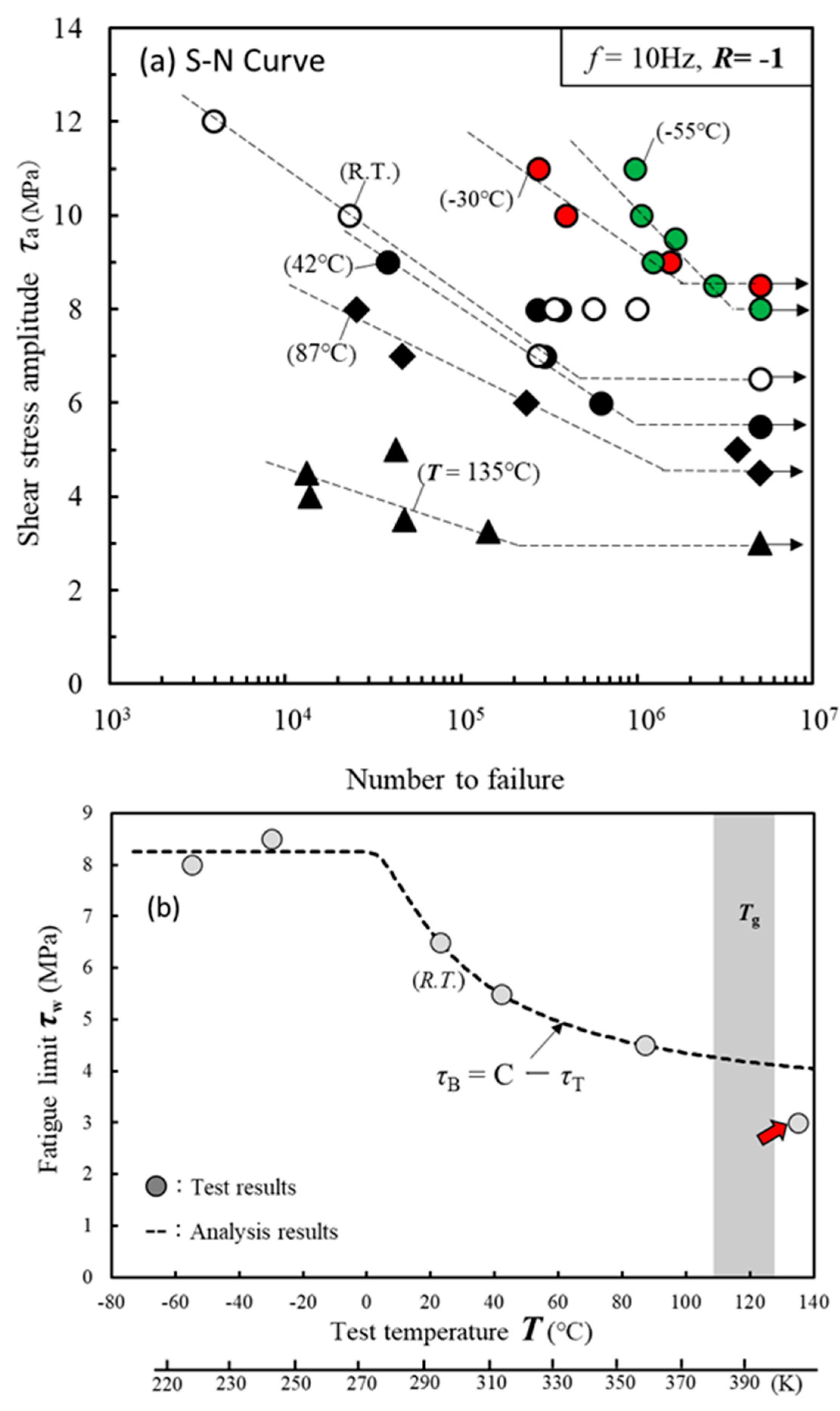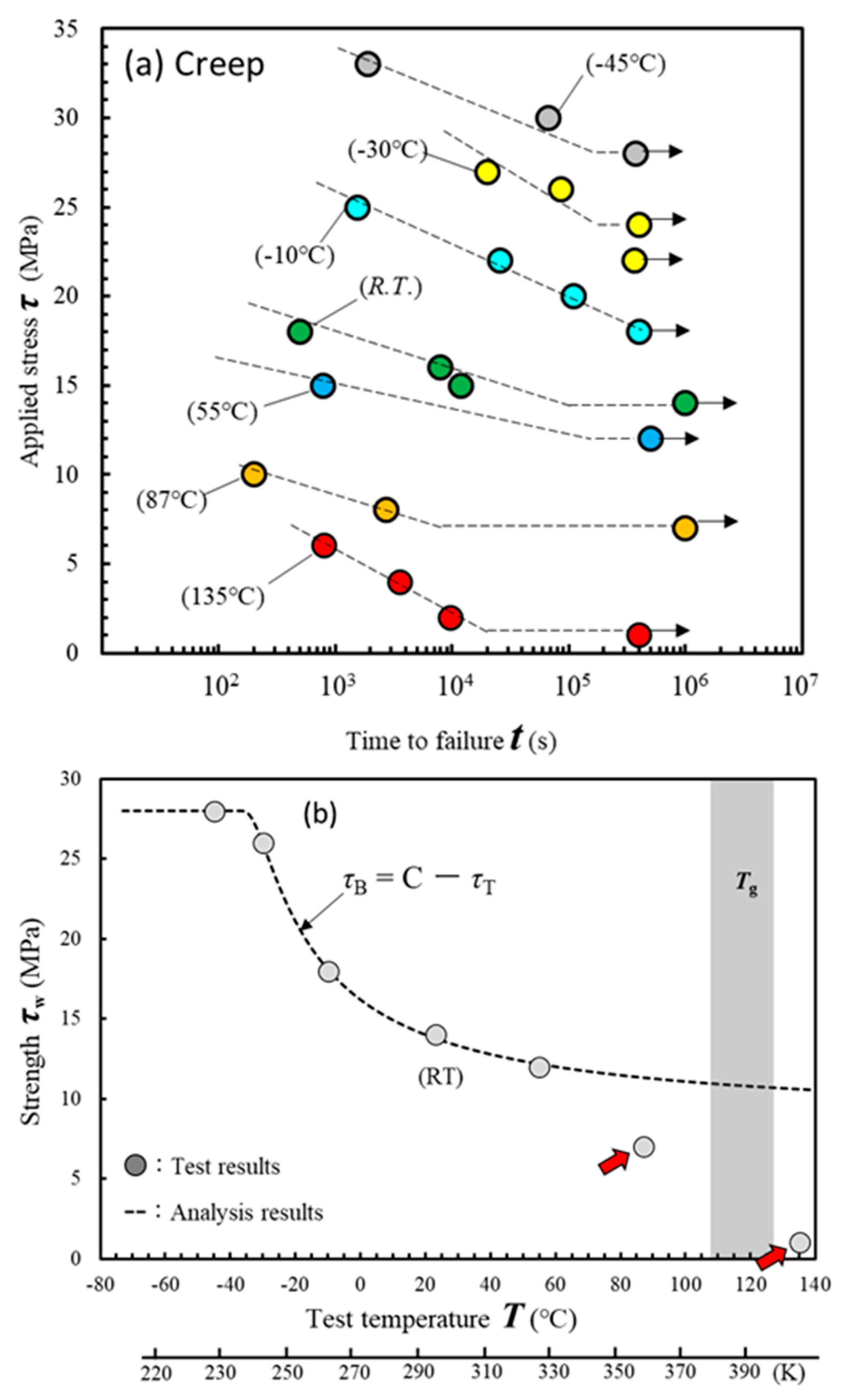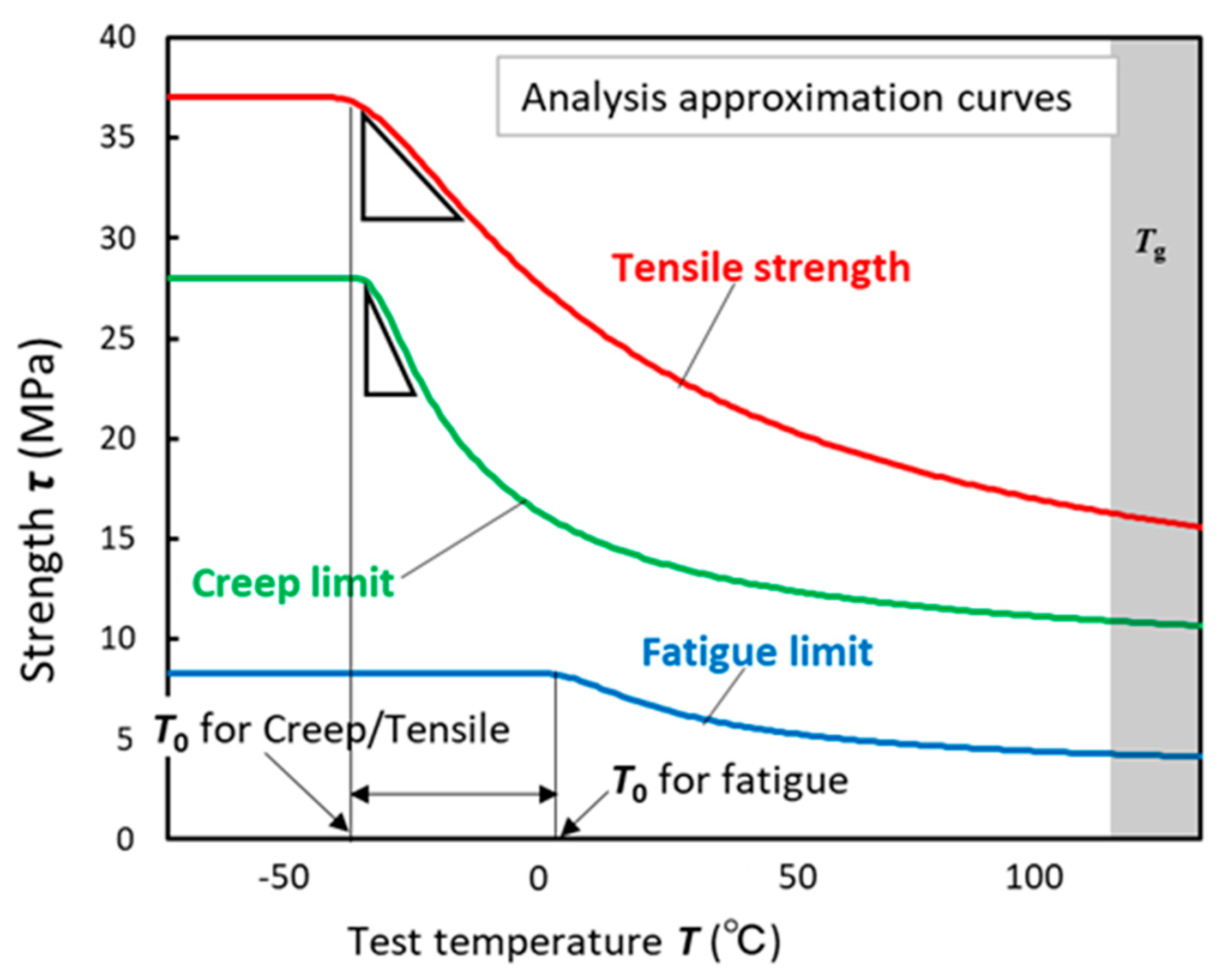Analytical Calculation of Relationship Temperature and Fatigue and Creep Strength Based on Thermal Activation
Abstract
:1. Introduction
2. Specimen and Experimental Procedure
2.1. Adhesive
2.2. Test Specimen
2.3. Experimental Procedure
3. Results and Discussion
3.1. Relationship between Test Temperature and Shear Strength
3.2. Relationship between Test Temperature and Fatigue Strength
3.3. Relationship between Test Temperature and Creep Strength
3.4. Temperature Dependence of LJ Strength
4. Conclusions
- (1)
- Tensile strength, fatigue limit, and creep limit improved with lower test temperatures; however, no improvement occurred below a certain temperature.
- (2)
- The relationship between test temperature and strength can be approximated using a thermal activation equation.
- (3)
- In long-term high-temperature tests, such as 135 °C fatigue tests, the adhesive deteriorates and does not follow the established curve.
- (4)
- Observations of the fracture surface in the fatigue test revealed that brittle fracture occurred when the test temperature was low, whereas ductile fracture occurred when it was high.
- (5)
- The T0 point for fatigue was higher than those of the other tests, and the temperature sensitivity of strength, represented by H, was highest in the creep test.
- (6)
- A method to express the temperature dependence of adhesive strength using constants T0 and H was proposed.
Author Contributions
Funding
Institutional Review Board Statement
Informed Consent Statement
Data Availability Statement
Conflicts of Interest
References
- Joost, W.J. Reducing Vehicle Weight and Improving U.S. Energy Efficiency Using Integrated Computational Materials Engineering. JOM 2012, 64, 1032–1038. [Google Scholar] [CrossRef]
- Miller, W.S.; Zhuang, L.; Bottema, J.; Wittebrood, A.J.; De Smet, P.; Haszler, A.; Vieregge, A. Recent development in aluminum alloys for the automotive industry. Mater. Sci. Eng. A 2000, 280, 37–49. [Google Scholar] [CrossRef]
- Ferreira, J.A.M.; Reis, P.N.; Costa, J.D.M.; Richardson, M.O.W. Fatigue behavior of composite adhesive lap joints. Compos. Sci. Technol. 2002, 62, 1373–1379. [Google Scholar] [CrossRef]
- Da Silva, L.F.M.; Sato, C. Design of Adhesive Joints under Humid Condition; Springer: Berlin/Heidelberg, Germany, 2013. [Google Scholar] [CrossRef]
- Puigvert, F.; Crocombe, A.D.; Gil, L. Fatigue and creep analyses of adhesively bonded anchorages for CFRP tendons. Int. J. Adhes. Adhes. 2014, 54, 143–154. [Google Scholar] [CrossRef]
- Savvilotidou, M.; Keller, T.; Vassilopoulos, A.P. Fatigue performance of a cold-curing structural epoxy adhesive subjected to moist environments. Int. J. Fatigue 2017, 103, 405–414. [Google Scholar] [CrossRef]
- Houjou, K.; Shimamoto, K.; Akiyama, H.; Sato, C. Dependence of fatigue limit on stress ratio and influence of cyclic stress on shear strength for an adhesive lap joint. J. Adhes. 2021, 97, 1153–1165. [Google Scholar] [CrossRef]
- Houjou, K.; Shimamoto, K.; Akiyama, H.; Sato, C. Effect of cyclic moisture absorption/desorption on the strength of epoxy adhesive joints and moisture diffusion coefficient. J. Adhes. 2022, 98, 1535–1551. [Google Scholar] [CrossRef]
- Houjou, K.; Sekiguchi, Y.; Shimamoto, K.; Akiyama, H.; Sato, C. Energy release rate and crack propagation rate behavior of moisture-deteriorated epoxy adhesives through the double cantilever beam method. J. Adhes. 2023, 99, 1016–1030. [Google Scholar] [CrossRef]
- Banea, M.D.; da Silva, L.F.M.; Campilho, R.D.S.G.; de Jesus, A.M.P. Characterization of aluminum single-lap joints for high temperature applications. Mater. Sci. 2013, 730–732, 721–726. [Google Scholar] [CrossRef]
- Jingxin, N.A.; Liu, Y.; Wang, Y.; Pan, L.; Yan, Y. Effect of Temperature on the Joints Strength of an Automotive Polyurethane Adhesive. J. Adhes. 2016, 92, 52–64. [Google Scholar]
- Adams, R.D.; Coppendale, J.; Mallick, V.; Al-Hamdan, H. The effect of temperature on the strength of adhesive joints. Int. J. Adhes. Adhes. 1992, 12, 185–190. [Google Scholar] [CrossRef]
- Wrosch, M.; Xian, G.; Karbhari, V.M. Moisture absorption and desorption in a UV cured urethane acrylate adhesive based on radiation source. J. Appl. Polym. 2008, 107, 3654–3662. [Google Scholar] [CrossRef]
- da Silva, L.F.M.; Adams, R.D. Adhesive joints at high and low temperatures using similar and dissimilar adherends and dual adhesives. Int. J. Adhes. Adhes. 2007, 27, 216–226. [Google Scholar] [CrossRef]
- Houjou, K.; Shimamoto, K.; Akiyama, H.; Sato, C. Effect of test temperature on the shear and fatigue strengths of epoxy adhesive joints. J. Adhes. 2022, 98, 2599–2617. [Google Scholar] [CrossRef]
- Argon, A.S. A theory for the low-temperature plastic deformation of glassy polymers. Philos. Mag. 1973, 28, 839–865. [Google Scholar] [CrossRef]
- Bascom, W.D.; Cottington, R.L. Effect of temperature on the adhesive fracture behavior of an elastomer-epoxy resin. J. Adhes. 1976, 7, 333–346. [Google Scholar] [CrossRef]
- Li, W.; Zhang, X.; Kou, H.; Wang, R.; Fang, D. Theoretical prediction of temperature dependent yield strength for metallic materials. Int. J. Mech. Sci. 2016, 105, 273–278. [Google Scholar] [CrossRef]
- Williams, M.L.; Landel, R.F.; Ferry, J.D. Temperature dependence of relaxation mechanism in amorphous polymers and other glass-forming liquids. J. Am. Chem. Soc. 1955, 77, 3701–3707. [Google Scholar] [CrossRef]
- Gent, A.N.; Lai, S.-M. Interfacial bonding, energy dissipation, and adhesion. J. Polym. Sci. B Polym. Phys. 1994, 32, 1543–1555. [Google Scholar] [CrossRef]
- Shanahan, M.E.R.; Garré, A. Viscoelastic dissipation in wetting and adhesion phenomena. J. Am. Chem. Soc. 1995, 11, 1396–1402. [Google Scholar] [CrossRef]
- Shioya, M.; Kuroyanagi, Y.; Ryu, M.; Morikawa, J. Analysis of the adhesive properties of carbon nanotube- and graphene oxide nanoribbon-dispersed aliphatic epoxy resins based on the Maxwell model. Int. J. Adhes. Adhes. 2018, 84, 27–36. [Google Scholar] [CrossRef]
- Li, X.; Schnecken, S.; Simon, E.; Bergqvist, L.; Zhang, H.; Szunyogh, L. Tensile strain-induced softening of iron at high temperature. Sci. Rep. 2015, 5, 16654. [Google Scholar] [CrossRef] [PubMed]
- Maraveas, C.; Fasoulakis, Z.C.; Tsavdaridis, K.D. Mechanical properties of High and Very High Steel at elevated temperatures and after cooling down. Fire Sci. Rev. 2017, 6, 3. [Google Scholar] [CrossRef]
- Kumazawa, H.; Nakagawa, H.; Saito, T.; Ogawa, T. Effect of cryogenic environment on strength properties of double-lap composite joints. J. Compos. Mater. 2020, 46-4, 150–161. (In Japanese) [Google Scholar] [CrossRef]
- Shimamoto, K.; Batorova, S.; Houjou, K.; Akiyama, H.; Sato, C. Degradation of epoxy adhesive containing dicyandiamide and carboxyl-terminated butadiene acrylonitrile rubber due to water with open-faced specimens. J. Adhes. 2021, 97, 1388–1403. [Google Scholar] [CrossRef]








| Material | Mass % |
|---|---|
| Bisphenol A epoxy resin | 24 |
| CTBN-modified epoxy resin (elastomer 40%) CTBN; carboxyl-terminated butadiene acrylonitrile rubber | 39 |
| Fumed silica | 3 |
| Filler (CaCO3) | 26 |
| CaO | 2 |
| Dicyane diamide | 5 |
| 3-(3,4-dichlorophenyl)-1,1′-dimethylurea | 1 |
| Bulk Mechanical Properties [7,9] | |
|---|---|
| Tensile strength at R.T. (MPa) | 30 |
| Young’s modulus at R.T. (MPa) | 1100 |
| Poisson’s ratio at R.T. | 0.41 |
| Tg point (°C) | 110–125 |
| Test Type | T0 (℃) | H (Q/B) (×103K/mol) |
|---|---|---|
| Tensile | −49 | 54 |
| Fatigue | −3 | 28 |
| Creep | −39 | 19 |
Disclaimer/Publisher’s Note: The statements, opinions and data contained in all publications are solely those of the individual author(s) and contributor(s) and not of MDPI and/or the editor(s). MDPI and/or the editor(s) disclaim responsibility for any injury to people or property resulting from any ideas, methods, instructions or products referred to in the content. |
© 2024 by the authors. Licensee MDPI, Basel, Switzerland. This article is an open access article distributed under the terms and conditions of the Creative Commons Attribution (CC BY) license (https://creativecommons.org/licenses/by/4.0/).
Share and Cite
Houjou, K.; Shimamoto, K.; Akiyama, H.; Sekiguchi, Y.; Sato, C. Analytical Calculation of Relationship Temperature and Fatigue and Creep Strength Based on Thermal Activation. Materials 2024, 17, 3055. https://doi.org/10.3390/ma17133055
Houjou K, Shimamoto K, Akiyama H, Sekiguchi Y, Sato C. Analytical Calculation of Relationship Temperature and Fatigue and Creep Strength Based on Thermal Activation. Materials. 2024; 17(13):3055. https://doi.org/10.3390/ma17133055
Chicago/Turabian StyleHoujou, Keiji, Kazumasa Shimamoto, Haruhisa Akiyama, Yu Sekiguchi, and Chiaki Sato. 2024. "Analytical Calculation of Relationship Temperature and Fatigue and Creep Strength Based on Thermal Activation" Materials 17, no. 13: 3055. https://doi.org/10.3390/ma17133055







